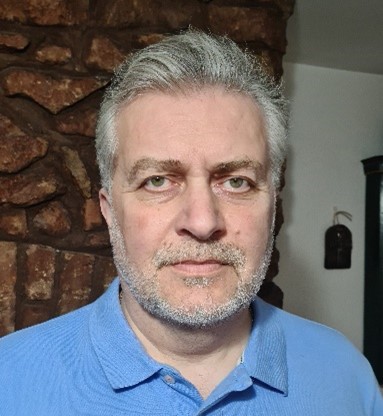Meet SPS Member Alin Achim


Professor Alin Achim
Professor, University of Bristol,
School of Computer Science
Professor Achim's Biography:
Professor Alin Achim received the B.Sc. and M.Sc. degrees in electrical engineering from “Politehnica” University of Bucharest, Romania, in 1995 and 1996, respectively, and the Ph.D. degree in biomedical engineering from the University of Patras, Greece, in 2003. He then obtained an European Research Consortium for Informatics and Mathematics (ERCIM) Post-doctoral Fellowship, which he spent with the Institute of Information Science and Technologies (ISTI-CNR), Pisa, Italy, and the French National Institute for Research in Computer Science and Control (INRIA) Sophia Antipolis, France. In October 2004, he joined the Department of Electrical and Electronic Engineering, University of Bristol, U.K., as a Lecturer, where he became a Senior Lecturer (Associate Professor) in 2010 and a Reader in biomedical image computing in 2015. Since August 2018, he holds the Chair of Computational Imaging, at the University of Bristol. From 2019 to 2020, he was a Leverhulme Trust Research Fellow with the Laboratoire I3S, Université Cote d’Azur. He was awarded a Chair of Excellence by the University of the Code d’Azur in 2020.
Alin has coauthored over 200 scientific publications, including 66 journal articles. His research interests include statistical signal, image, and video processing and machine learning, with applications in both biomedical imaging and Earth Observation. He was/is an Elected Member of the Bio Imaging and Signal Processing Technical Committee of the IEEE Signal Processing Society, an Affiliated Member (invited) of the Signal Processing Theory and Methods Technical Committee, and a member of the IEEE Geoscience and Remote Sensing Society’s Image Analysis and Data Fusion Technical Committee. He was/is an Associate Editor / Senior Area Editor of the IEEE Transactions on Image Processing, and of the IEEE Transactions on Computational Imaging.
Why Did You Choose to Become Faculty in the Field of Signal Processing?
It was a combination of following the opportunities and … genetics. My parents are both (retired) teachers, hence not very practical persons, and upon graduating with my BSc in Electrical Engineering I found myself questioning whether I really acquired the practical skills to land a job as an engineer. After a short spell in a telecommunications company in Bucharest (Electromagnetica S.A.), while in parallel doing an MSc in Microelectronics, I decided to embark on a PhD, hoping that it will help me better mix theory and practice. From there everything ensued, and I got swallowed into the academic career pathway: PhD, postdoc, a job opening as lecturer at the University of Bristol, and 21 years later I’m still there … As for why in Signal Processing – same reason: it is the most mathematical, hence theoretical, subject I studied at university. By the way, my father used to be a maths teacher.
How Does Your Work Affect Society?
My work involves computational imaging and image processing and throughout my career I sought applications primarily in two rather distinct domains: medical and biological imaging and Earth Observation via remote sensing. From this perspective my work affects society in very different ways. On the one hand, medical and biological imaging involves the development of novel algorithms and methods for enhancing image quality and for information extraction thereof. When implemented into medical imaging devices, these in turn help clinicians achieve faster and more accurate diagnosis. The main beneficiary is ultimately the patient. On the other hand, Earth Observation has multiple applications, both civilian and military. These include as example: space exploration; navigation and equipment positioning; object detection, classification, tracking, or avoidance; remote sensing of oceanographic phenomena; natural disaster management; even law enforcement by monitoring possible illegal activities.
What Challenges Have You Had to Face to Get Where You Are Today?
I can’t really think of anything significant to single out. It was rather a succession of steps taken and which were the result of choices I had to make as everyone does in their life. Perhaps the challenge of leaving my country and my extended family all those years ago and adapting to new ways of living and new languages in four different European countries before I eventually settled in the UK. But rather than calling that challenging, I would call it enriching!
Strictly in terms of developing my research career, I always hated following the crowd and jumping at whatever became hot at a particular moment. I must admit that I resisted for many years getting into AI/ML research and tried to stay true to my lifelong quest for designing better solutions to imaging inverse problems by exploiting the statistical characteristics of the data. Without having completely given in, I hope to have found the right middle ground by choosing instead to adapt my interests to the new trends. Hence, in recent years I have been investigating methods that combine classical model-based approaches with modern data-driven deep learning techniques.
What Advice Would You Give to Scientists/Engineers in Signal Processing?
My advice would be to always keep applications in mind when developing new methods and if possible, focusing on more than one, potentially from completely different domains: While developing a deep understanding of one domain (or type of signal you are working with) is crucial to producing high quality signal processing methods, there are lots of benefits to be had through being involved with a multitude of diverse applications. There are always synergies and complementarities that could inspire developments in one field by borrowing ideas from another. Examples abound and can include fields as diverse as Earth Observation and medical imaging, or microscopy and astronomy, or yet physiological signals and sound or speech processing.

